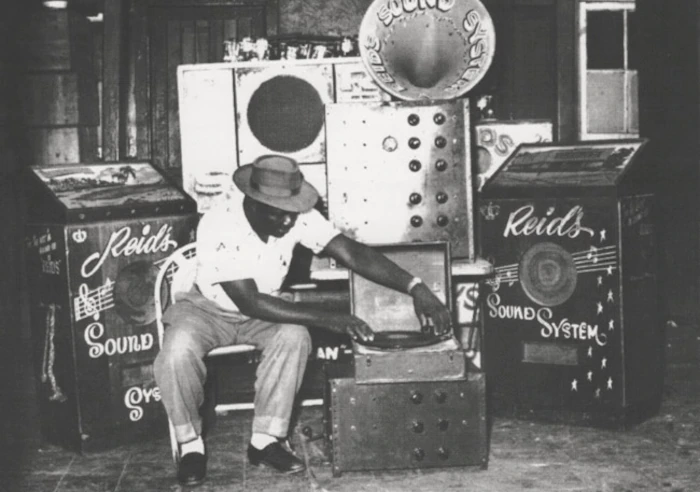Colloquially, New Orleans has been called the northernmost point of the Caribbean. But what does that mean beyond its role as a major port of trade?
In the late 1940s and 50s, the piano kings of New Orleans were lighting a fire that would eventually be called rock and roll. Legends like Fats Domino, Professor Longhair, and Allen Toussaint were re-writing the history of popular music, and major labels took notice.
“The Fat Man,” by Fats Domino, widely considered the first rock and roll record, was released in 1950 on the Imperial label. The record sold over a million copies and was licensed for distribution in the UK through London Recordings. This is almost certainly part of the story of the first chapter of rhythm and blues in Jamaica, a story that would take hold of a nation, and later, the world.
When Fats Domino came to Jamaica in 1961, he found a style of music he created himself, reimagined. The style was a new Jamaican version of rhythm and blues. The shuffle piano rhythms evolved into a sound that would become something entirely new.
Well into the 1960s, Domino’s piano feel, a signature of New Orleans music, made its way to Jamaica. The Ska guitar and piano pattern certainly borrowed from Domino’s piano technique, but with a stronger emphasis on the right-hand, off-beat. This specific rhythm pattern would define the sound of Jamaican music for the next 60 years. The accent on the right-hand remained intact even as the bass lines and drum patterns evolved throughout the eras of Jamaican popular music.
As the sound of New Orleans spread across the world, it’s clear that the region’s music made a strong impression on the development of popular music in Jamaica. Covers of songs, popularized by New Orleans rhythm and blues artists, were pressed to records on the British Bluebeat label.
Blue Beat was named by label manager Siggy Jackson. He would famously say “It sounds like blues and it’s got a great beat.” In fact, Blue Beat was the signature sound at 33 Bond Street in Kingston where Duke Reid was operating the Treasure Isle Grocery and Liquor Store. Duke Reid would use this location to host a public announcement system in 1953; the birth of the Jamaican Sound System.
By 1961, Duke Reid was crowned by his followers as “King of Sound and Blues.” It was in this same year that Reid himself crowned Fats Domino “King of Rhythm and Blues.”
Much of the same story has been repeated in publications about the method in which the music from New Orleans made its way to listeners in Jamaica. Certainly, the sound system was a dominant medium of distribution. However, it has been repeated time and again that these sounds reached Jamaica by radio station signals from the Gulf South.
As a New Orleanian, there is much left to be desired from this narrative. Which station exactly? Which physical records made their way to Jamaica from New Orleans?
Speaking to the Jamaican Gleaner in 2008 about the influence of New Orleans rhythm and blues, Derrick Morgan said, “Professor Longhair and those guys were so great, that’s who we were imitating. Then it turned out to be a different thing in Jamaica, so we gave it a new name: ska.”
Today, we can follow history through the artifacts that drove the evolution of sound: records. We can trace the connection between the two cultures through some of the songs that are most indicative of the bridge across the Gulf.
Here are my top ten records that make the connection from New Orleans to Jamaica:
- Derrick and Patsy: “Let the Good Times Roll” (Jamaica)
Shirley and Lee: “Let the Good Times Roll” (New Orleans)
2. Duke Reid and His Group: “Duke’s Cookies” (Jamaica)
This tune really puts a Jamaican spin on the classic New Orleans piano feel we hear in songs like Professor Longhair’s “In the Night” (New Orleans)
3. Jackie Edwards: “Sea Cruise” (Jamaica, 1964)
Frankie Ford: “Sea Cruise” (New Orleans, 1959)
4. Shenley Duffus: “I’m a Lonely Boy” (Jamaica)
Clarence “Frogman” Henry: “Aint Got No Home” (New Orleans) Clarence recorded his version in 1956 at Cosimo Matassa’s studio in New Orleans. The song reached number 20 on the billboard pop charts that year. Shenley later released his version in 1964 on Blue Beat
5. Alton Ellis & The Flames: “Something You Got” (Jamaica)
Chris Kenner: “Something you Got” (New Orleans)
6. Nicky Thomas: “Tell it Like it Is” (Jamaica)
Aaron Neville: “Tell it Like it Is “ (New Orleans)
7. The name Allen Toussaint is penned to many of the most important songs in American popular music history and Jamaican music is no exception. Toussaint wrote “Get Out of My Life Woman” and it was recorded by Lee Dorsey in 1965. This particular version was released by the Mighty Diamonds in 1977, demonstrating that the impact of Toussaint’s composition was both widespread and long lasting.
The Mighty Diamonds: “Get Out of My Life Woman” (Jamaica)
Lee Dorsey: “Get Out of My Life Woman” (New Orleans)
8. By the 1980s, dancehall was in full swing, and the echoes of popular songs from the Gulf South continued to leave their mark. Yellowman famously released his own version of Fats Domino’s “Blueberry Hill” in 1987, and the impact of New Orleans phraseology seems to appear throughout the genre.
Yellowman: “Blueberry Hill” (Jamaica)
Fats Domino: “Blueberry Hill” (New Orleans)
9. “Wings of Love” by Trevor Sparks again quotes phrasing from “Ain’t Got No Home,” released 30 years prior.
Trevor Sparks: “Wings of Love” (Jamaica)
Clarence “Frogman” Henry: “Aint Got No Home” (New Orleans)
10. The marriage of Jamaican and New Orleans rhythm and blues continues into the hip-hop era with Supercat’s 1995 release of “My Girl Josephine” with Jack Radics singing Fats’ classic hook.
Supercat feat. Jack Radics: “My Girl Josephine” (Jamaica)
Fats Domino: “My Girl Josephine” (New Orleans)

